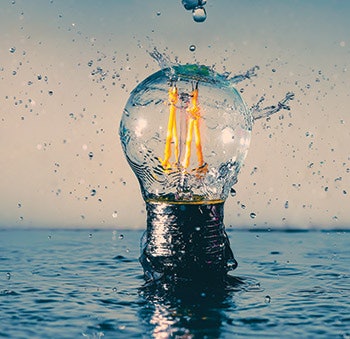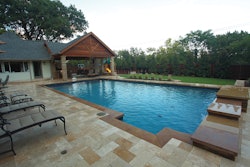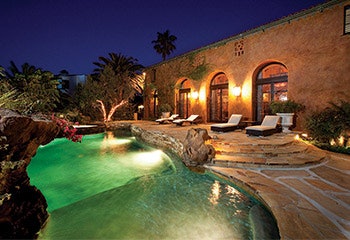 Lighting, both inside the pool and in the landscape, has been dramatically enhanced by the advent of LED technology, which we use on all of our projects.
Lighting, both inside the pool and in the landscape, has been dramatically enhanced by the advent of LED technology, which we use on all of our projects.
Fifty years is a long time to do anything. When that pursuit is something as multifaceted as custom pool design and construction, it's amazing how the decades fill up and fly by.
This year marks a half-century that I've been creating backyard oases, these days for high-end clients in Southern California with my company, Ultimate Water Creations (Los Angeles, Calif.). About half of our work is new construction, the other half remodels.
When we talk about remodels, I don't consider basic aesthetic upgrades in that category. When you paint your house, for example, most people don't consider that a remodel. Upgrading the interior pool surface can certainly make a great difference in the appearance of the pool, but that's not the essence of a major remodel.
 BEFORE: Our renovations often start with pools that are functional, but badly lacking in aesthetic design. (Photos courtesy of Ultimate Water Creations)
BEFORE: Our renovations often start with pools that are functional, but badly lacking in aesthetic design. (Photos courtesy of Ultimate Water Creations)
That said, we do take the surface aesthetics very seriously. These days, we have all sorts of alternatives to traditional white plaster, which we never use anymore. Instead we turn to pebble surfaces, Hydrazzo or Beadcrete, which are wonderful products that are both more durable than regular plaster and far more attractive. We'll also replace existing surfaces with all-tile, usually 1-by-one-inch glass tile, which is the most beautiful, enduring and expensive product we have at our disposal.
Similarly we'll turn to any number of quality deck materials instead of more familiar options such as stamped or salted concrete surfaces, which don't look too good to start with and certainly don't maintain their appearance. The variety of stone materials, tiles and materials, like travertine, can have a great impact on the look and ambiance of the area around the pool. And, if maintained properly, they last far longer than most types of decorative concrete.
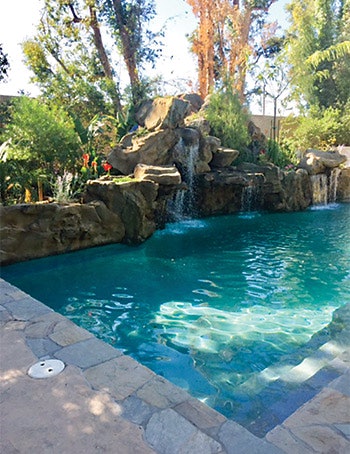 AFTER: Our renovation projects go well beyond simply replacing the plaster, coping and deck material and often include significant changes to the pool shell and surrounding structures. (Photos courtesy of Ultimate Water Creations)
AFTER: Our renovation projects go well beyond simply replacing the plaster, coping and deck material and often include significant changes to the pool shell and surrounding structures. (Photos courtesy of Ultimate Water Creations)
But, again, none of those things are what I would call a remodel. Instead, a true remodel or renovation is a project where you significantly alter the pool structure. Yes, we will use all or portions of the existing shell, assuming it's structurally sound, but when we're finished, the odds are the scene will be completely transformed from its original appearance.
We'll alter the shape, size and internal step, bench and step structures. We may add architectural elements such as raised walls, significant artificial or natural rock structures (a topic for a future discussion) and often change the floor.
RELATED: The $90 Million Renovation
REWORKING THE STRUCTURE
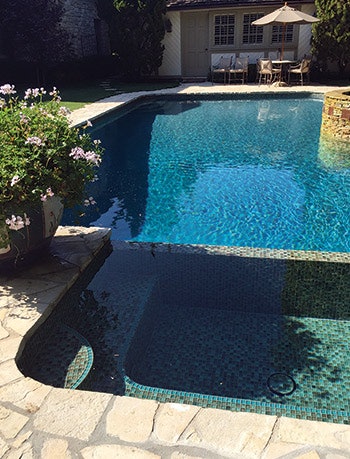 AFTER
AFTER
Basically anything you can do during original construction you can do in a remodel. As pools and their surrounds have become more multifaceted and creative, we've worked to incorporate innovations when they make sense, and fit the budget.
Certainly there's an entire spectrum of major remodel features, from vanishing edges, perimeter overflows, beach entries, attached spas, grottos, slides, fire features, outdoor kitchens and even sport courts.
One of the most common trends these days is to elevate the floor — in other words, we remove the deep end. Doing so is a huge job that's actually pretty simple in concept.
Using the original floor as a form, we dowel in added structural steel and shoot the bottom of the pool with new gunite to the desired depth. Most of our projects, new and remodel, are using all-shallow bottoms because most homeowners recognize that the deep end is mostly wasted space. You can dive in the deep water and that's really about it.
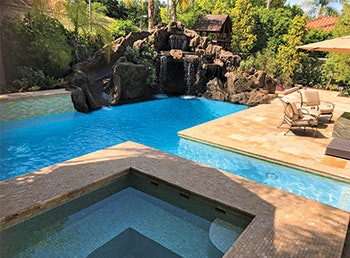 AFTER
AFTER
We've found that even avid swimmers like to be able to touch the bottom throughout the pool, and the vast majority of people will either walk around in the water or lounge on the steps, benches or shelves. With an all-shallow pool they're far more likely to spend more time in it and find greater enjoyment. Shallow pools are great for games and for kids who might not be competent enough for a deep end.
TECHNICAL PERFECTION
The aesthetics are, of course, important because that's what people see when they walk in their backyard. But it's important to apply the same level of discipline on the purely technical side. That means our plumbing systems are designed for efficiency, and we take great care in where we put our returns, skimmers and drains. We use variable speed pumps, advanced control systems and chemical treatment technology that reduces the need for chlorine.
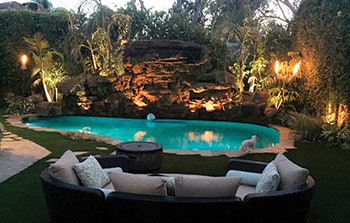 The combination of rockwork, landscaping, lighting and water give us tremendous creative opportunities, even in projects that are relatively modest in size and scope. (Photos courtesy of Ultimate Water Creations)
The combination of rockwork, landscaping, lighting and water give us tremendous creative opportunities, even in projects that are relatively modest in size and scope. (Photos courtesy of Ultimate Water Creations)
RELATED: Renovation to the Rescue!
Everything we do on the technical side is designed to last and give the homeowners the most trouble-free maintenance possible. An all-shallow pool, for example, not only enhances the way people use the water — it also helps from a technical standpoint simply by virtue of the fact that you're circulating less water, filtering less and treating less. It's also much less expensive to heat.
Those types of practical considerations may not always be the first thing on the homeowners' minds, but I know from experience that when you establish systems that work reliably and are more easily maintained, you remove distractions and frustrations that compromise the homeowners' enjoyment of their pools and surrounding areas.
In the end, to clear that high bar, you've got to pay attention to every aspect of the work, and it doesn't hurt to have five decades experience behind those best efforts.
Questions or comments about this story? Please email [email protected]
|
THE LED CONNECTIONWe use LED lighting on every job. We combine LED lighting in the pool, of course, in water features and within the landscape that surrounds the water. We bring in an expert I've known for years, Bruce Dennis of Lightcraft Outdoor Environments in Chatsworth, Calif., a company that both manufactures LED fixtures and does lighting designs. I'll have an idea about where I want the lights to go and the effects we're trying to achieve. We walk the site and then Bruce develops the specific design, including fixture selection and location. Many homeowners go with inexpensive Home Depot types of lighting fixtures for their backyards, which are menial to poor when it comes to the construction of the fixture itself. They're not LED, which is a superior technology, and these lesser products go bad often over a relatively short period of time. They rot out because they allow water into the housing; they short out the transformers and basically just stop working. Other people I know use spotlights that hang on their house. These are very bright, high-output fixtures with lots of glare. There's no mood or ambiance to them. These fixtures often leave customers frustrated and not able to fully enjoy their outdoor environments the way they had hoped. By the time they come to us, they've already decided they want something better. With today's LED lights, we can do so much better for our clients. We can create truly beautiful scenes that come alive at night and will function reliably for a long, long time. Yes, it's more expensive, but there's no comparison in terms of durability, reliability and aesthetics. I try to educate the homeowner about the advantages as well as the range of things we can do. For example, on a small number of projects we'll use an extremely expensive system where everything's entirely programmable with multiple colors in every fixture. You can control the mood with different settings and program the lights so the scene is constantly changing. That's great for some clients, but I've found that most people, even those who can afford the technology, don't really and truly use the system. Even on our extremely high-end projects, we can oftentimes achieve the desired lighting effects with quality fixtures at a reasonable cost. One thing we hear about with LED lights from time to time but doesn't really come into play is the safety aspect. As with any type of lighting, if you follow NEC recommendations, those systems are going to be safe. In a sense, lighting safety is just like hydraulic safety: Do the job right using proven standards and recommendations and the environment will be safe. You really only run into trouble if you cut corners, which no one should ever do with any type of electrical installation. LEDs do offer advantages that appeal to different customers for different reasons. There are some, for example, who want to save the world and use less energy. We're happy to accommodate that desire and point out how little electricity LEDs use. Far more common are those clients who simply want their pools and landscapes to look great and operate reliably. That's the main reason you use LEDs in new construction and remodels: visual impact. And when you work with a talented lighting designer, it's amazing what you can achieve. Because so many people only see their backyards at night due to their busy careers, there's an opportunity to create tremendous value by working with the multitude of lighting effects you can achieve in and around the water. We are also often in the business of correcting design errors. The most common example are those pools where you have one bright light on the deep end of the pool that almost inevitably glares right in the face of someone looking at the water from the house side. With multiple LED fixtures distributed throughout the vessel, we're able to create beautifully even light effects that don't cause undue glare. And let me conclude with this point: Landscape lighting is great, but water offers the greatest opportunity for visual impact. The movement of water, the way it refracts and reflects light, the way that lighting illuminates an entire body of water — all of those effects will inevitably impress clients the most. |




















